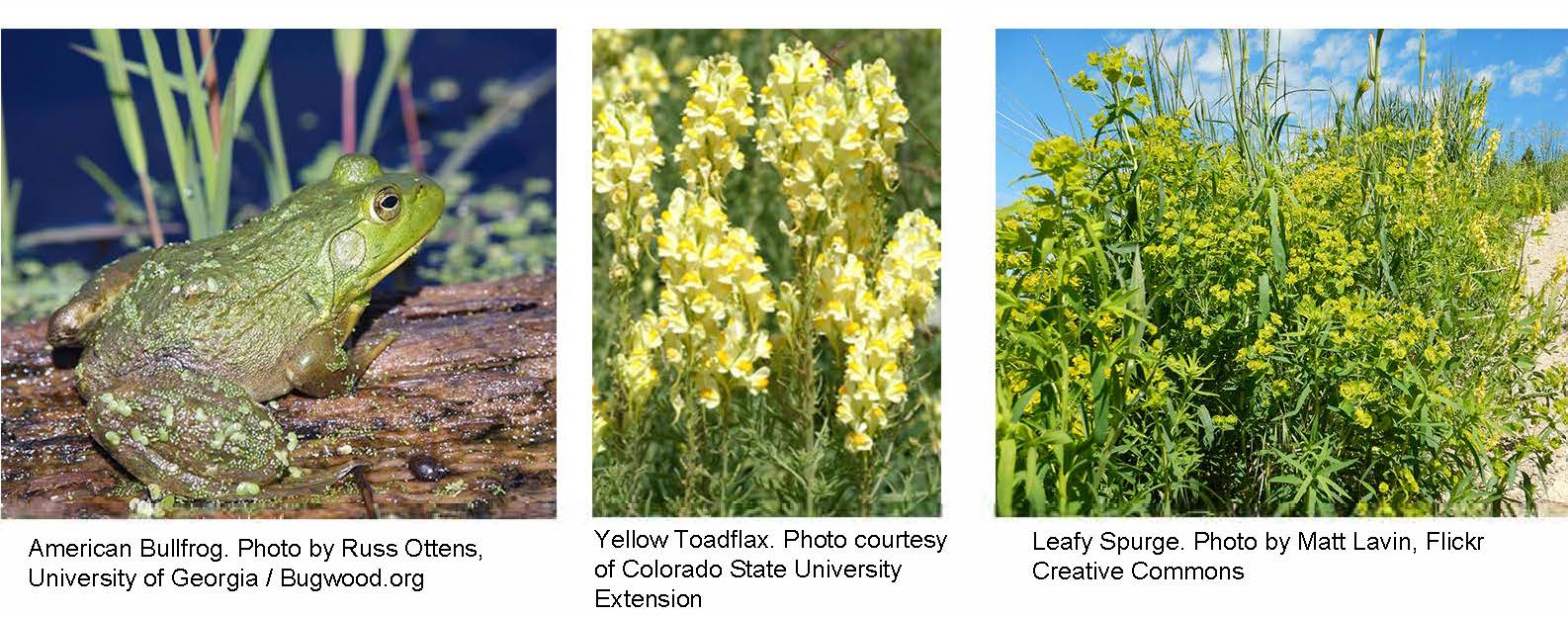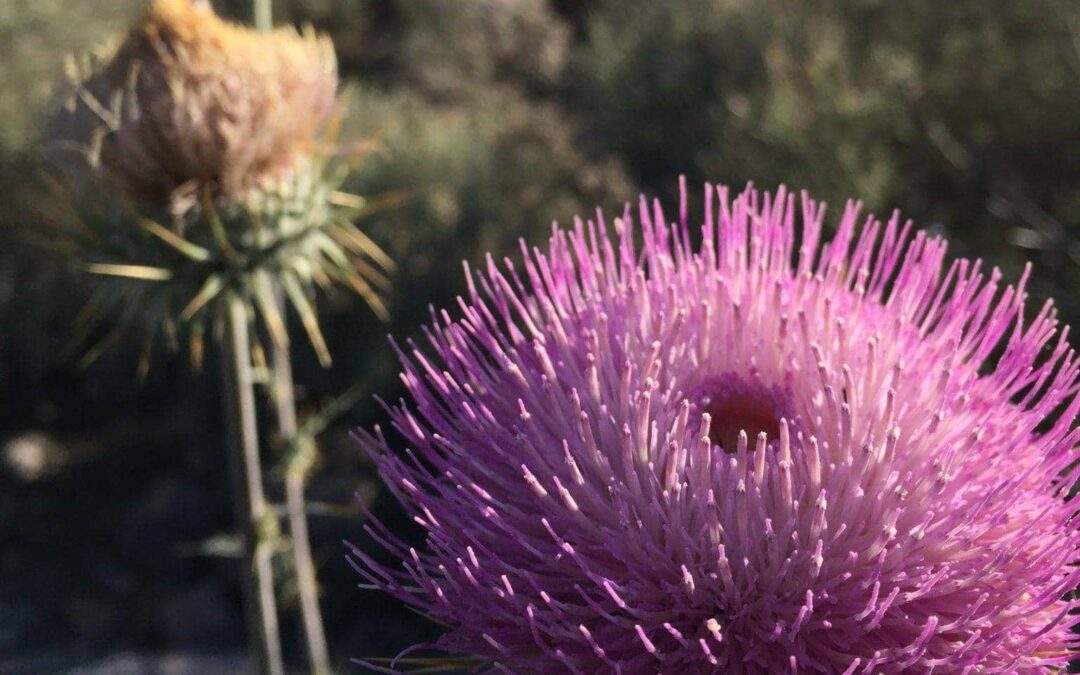By Francesca Governali
Did you know there are more than ten invasive plant species that can reliably be found along the Continental Divide? In fact, there are likely many more that have moved into the trail corridor from all around the country, and possibly the world. While you might not notice a species that is non-native to your environment, it could be having an outsized impact on that ecosystem.
According to the National Wildlife Federation, an invasive species is any kind of living organism – an amphibian, plant, insect, fish, fungus, bacteria, or even an organism’s seeds of eggs – that is not native to an ecosystem and causes harm. While not all non-native species are classified as invasive, those that are can cause harm to the environment, economy, or even human health.
Some of the invasive plant species you might find along the CDT include:
Idaho and Montana: Orange Hawkweed, Oxeye Daisy, Spotted Knapweed, Nodding Plumeless Thistle
Wyoming: Oxeye Daisy, Spotted Knapweed, Nodding Plumeless Thistle, Canada Thistle, Leafy Spurge, Cheatgrass
Colorado: Oxeye Daisy, Orange Hawkweed, Yellow Toadflax (known as Butter & Eggs), Canada Thistle
New Mexico: Canada Thistle, Cheatgrass, Nodding Plumeless Thistle

A small seed or individual plant can seem innocuous, but with the ability to spread quickly across a landscape, invasive species often outcompete natives and can create long-term ecological changes that damage the ecosystem. While aquatic invasive species are commonly talked about, along the CDT there are a number of terrestrial invasives that impact the trail corridor. We have partnered with PlayCleanGo, an organization dedicated to stopping the detrimental impact of invasive species to North America’s lands and waters. PlayCleanGo focuses on providing easy, actionable information to help all of us enjoy our beautiful natural resources responsibly. Some of the steps you can take to reduce possible spread of invasive species from ecosystem to ecosystem include: removing plants, animals, and mud from boots, gear, pets, and vehicles; cleaning your gear before entering and leaving a recreation site; staying on designated roads and trails; and using certified or local firewood and hay. Coming June 5 – June 12 is PlayCleanGo Awareness Week. Throughout the week, PlayCleanGo will share more information about invasive species and easy steps that members of the public can take to prevent their spread and even have a few contests.

Invasive species management along the CDT is part of the trail work undertaken by volunteers with CDTC and other organizations from New Mexico to Montana. In New Mexico’s Gila National Forest, Leia Barnett and Madeleine Carey work on WildEarth Guardians’ Greater Gila campaign. This campaign is focused on conservation across the whole landscape and is especially important because the Greater Gila Bioregion is home to many threatened species that are now dealing with invasive species impacting their habitats.
A recent effort led by New Mexico Game & Fish has proposed changing the status of the native narrow-headed garter snake, often thought of as an indicator species and used to monitor environmental changes in the Gila, from a state-threatened to a state-endangered species. As Barnett explains, “that particular species of garter snake is a habitat specialist, occurring only in shallow, swift-flowing rocky rivers and streams of the San Francisco and Gila drainages. Back in the 1990s they were known to inhabit over 40 different locations with three robust populations. Today they’re found in only seven out of 17 historical sites. Cows and invasive bullfrogs are two of the major threats to the snake.” While they are not focused on reducing the bullfrog populations at the moment, a large part of their work includes decreasing the number of cows on public lands in the Greater Gila region through grazing permit retirement work.
“Livestock grazing has existed since the beginning of European presence in the Gila, and it generally has been managed the same way since it began,” Carey explains. While cattle grazing makes up a large industry and way of life in New Mexico, in the Gila each cow can have a large ecological impact, especially in riparian (along rivers and streams) areas. Because of the dry climate, the riparian areas in the Gila (and New Mexico in general) are biodiversity hotspots. Cows like to eat the grass and brush in these areas which leads to erosion and increased turbidity (cloudiness due to dissolved sediment in the water) and temperatures of the water. This has cascading ecological effects for all species including cold water trout, narrow-headed garter snake, and, eventually, humans.
Because the habitat quality and connectivity has changed in the Gila watershed, invasive bullfrog populations are thriving. These bullfrogs eat the baby snakes, reducing the native population. As Madeleine reflects, “we as citizens, land managers, voters, people who love wild places are failing because another species will be added to the endangered species list.” The Gila National Forest and Wilderness Area is a protected area, but there is still a lot of work to be done to protect native species as habitats change.
So, if you’re ever in the Greater Gila Region, keep an eye out for bullfrogs, garter snakes, and cows and consider how each of the species might be impacting the region and how you experience it. Due to the interconnectedness of all the species in an environment, native and non-native, it is always difficult to address issues related to native and invasive species management, but a good first step is starting with awareness of the plant and wildlife dynamics around you. We’ll be working with our partners from PlayCleanGo, WildEarth Guardians, and others to grow awareness and protect native species along the Divide as we continue to learn about the invasive species along the trail.
If you’re curious about what invasive species might exist near you, check out species distribution maps from the University of Georgia’s EDD Maps Website. And, if you would like help identifying plants in your area, SnapChat has a plant ID feature and iNaturalist can be a great resource as well. Read more on PlayCleanGo’s website about what you can do to prevent the spread of invasive species while doing your favorite outdoor activity!
Follow PlayCleanGo on Facebook, Instagram, and Twitter to learn more and participate in the upcoming Awareness Week!
Francesca Governali is CDTC’s Community Engagement Coordinator. In her free time she has been improving her altitude baking skills, tackling her next big knitting project, and continues to enjoy getting to know Colorado’s public lands.

